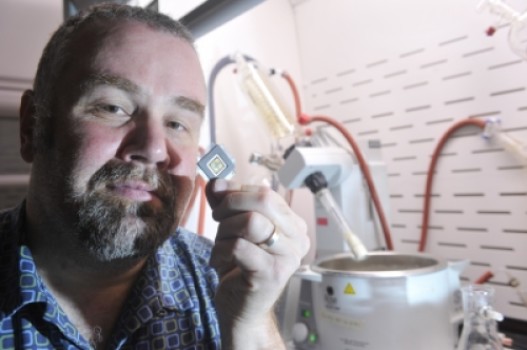
A new compound developed at the University of Toronto Scarborough could play an important role in developing cheaper anti-cancer drugs.
Professor Bernie Kraatz, chair of the Department of Physical and Environmental Sciences at U of T Scarborough, has developed a new compound that can be used to monitor the biochemical processes involved with a group of enzymes called protein kinases.
The prevailing form of monitoring kinase activity involves the use of radioactive isotopes, which is costly because the isotopes are expensive to use and have a short shelf life. They are also difficult to work with because of the regulations associated with their handling and disposal.
“We wanted to find a way to get around the hurdles involved with using radioactive isotopes,” says Kraatz. “Having a compound that can be used in live cells is important because it can help clinicians better monitor kinase activity and to determine if a drug they’re administering is effective in terms of regulating kinase activity.”
Protein kinases play an essential role in energy transfer within all living things including controlling cell division, growth and death while also regulating metabolic pathways and even cell communication. If protein kinase activity is not regulated properly it can lead to certain diseases, including cancer.
Kraatz’s team was able to develop a way to monitor the activity of protein kinase — in this case a sarcoma-related kinase — by using a redox label rather than a radioactive label. A redox label is a compound that provides an electrical signal that can be detected very accurately. The result is a safer, simpler and cheaper alternative to monitoring the efficiency of drugs and kinase activity.
“Chemists often come up with wonderful models and reactions but translating those into a biomedical environment can be very difficult,” says Kraatz. “We were able to take a fantastic label that can be used perfectly well in a biomedical environment.”
Another benefit of the compound developed by Kraatz and his team is that a fluorescence label can be attached to it, which gives off light that can be detected when excited. This is beneficial because it can produce an additional readout for clinicians trying to understand kinase activity or determine the effectiveness of a drug.
The research, which received funding from the Natural Sciences and Engineering Research Council of Canada, is available online in Chemistry — A European Journal.
Story Source:
The above story is based on materials provided by University of Toronto. The original article was written by Don Campbell. Note: Materials may be edited for content and length.
Journal Reference:
- Nan Wang, Zhe She, Yen-Chun Lin, Sanela Martić, David J. Mann, Heinz-Bernhard Kraatz. Clickable 5′-γ-Ferrocenyl Adenosine Triphosphate Bioconjugates in Kinase-Catalyzed Phosphorylations. Chemistry – A European Journal, 2015; DOI: 10.1002/chem.201405510
